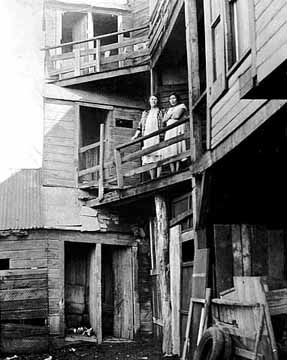Difference between revisions of "The West Side Flats"
m (Protected "The West Side Flats" [edit=sysop:move=sysop]) |
|||
| (One intermediate revision by one other user not shown) | |||
| Line 4: | Line 4: | ||
| − | Like [[Sumner-Glenwood]] in Minneapolis, the West Side Flats in St. Paul occupied some of the most unwanted land in the capital city. Resting a few feet above the river, the land flooded annually—this deluge varied according to the year’s spring snowmelt. At times, the floodwaters only covered a few inches of ground. In the flood of 1952, most fled their homes using rowboats.<small>(1)</small> | + | {| {{prettytable}} |
| + | ! | ||
| + | ! | ||
| + | |- | ||
| + | | Like [[Sumner-Glenwood]] in Minneapolis, the West Side Flats in St. Paul occupied some of the most unwanted land in the capital city. Resting a few feet above the river, the land flooded annually—this deluge varied according to the year’s spring snowmelt. At times, the floodwaters only covered a few inches of ground. In the flood of 1952, most fled their homes using rowboats.<small>(1)</small> | ||
Russian Jews escaped the deadly climate of post-Alexander II Russia, where pogroms threatened the lives of thousands.<small>(2)</small> After some established themselves in St. Paul, the Russian immigrants gathered enough funds to import their loved ones—by the turn of the century, the community grew to the extent that it needed an essential “Neighborhood House,” which provided essential social services.<small>(3)</small> | Russian Jews escaped the deadly climate of post-Alexander II Russia, where pogroms threatened the lives of thousands.<small>(2)</small> After some established themselves in St. Paul, the Russian immigrants gathered enough funds to import their loved ones—by the turn of the century, the community grew to the extent that it needed an essential “Neighborhood House,” which provided essential social services.<small>(3)</small> | ||
| + | An interesting and possibly queer site in this largely-forgotten period of St. Paul’s history sat on State Street. Long before indoor plumbing was a government expectation, West Siders used a community outhouse. | ||
| + | |<div style="text-align: center;"> | ||
| + | [[Image: Svc_wside.jpg]] | ||
| + | </div> <div style="text-align: center;"> | ||
| + | <small>'''The West Side's infamous 3-story outhouse, ca.1940. Image courtesy of the Minnesota Historical Society.'''</small> | ||
| + | </div> | ||
| + | |} | ||
| − | + | ||
| + | This structure, while unremarkable in terms of its use, was remarkable for its sheer size—at 3 stories, the makeshift wooden structure handled several “patrons” at the same time.<small>(4)</small> Public toilets offered quiet refuges for clandestine sexual activity long before underground queer communities established in the United States; possibly, the toilets offered one of few options to St. Paul’s Jews. | ||
| Line 17: | Line 29: | ||
St. Paul’s Jewish and Latino communities will never know if the West Side could have produced a vibrant queer community—the flood of 1952 prompted government intervention. Nearly every building on the flats vanished, and the City of St. Paul replaced the former neighborhood with an industrial park.<small>(7)</small> | St. Paul’s Jewish and Latino communities will never know if the West Side could have produced a vibrant queer community—the flood of 1952 prompted government intervention. Nearly every building on the flats vanished, and the City of St. Paul replaced the former neighborhood with an industrial park.<small>(7)</small> | ||
| + | |||
---- | ---- | ||
Latest revision as of 11:25, 1 May 2010
Across the Mississippi River from downtown St. Paul, MN
| Like Sumner-Glenwood in Minneapolis, the West Side Flats in St. Paul occupied some of the most unwanted land in the capital city. Resting a few feet above the river, the land flooded annually—this deluge varied according to the year’s spring snowmelt. At times, the floodwaters only covered a few inches of ground. In the flood of 1952, most fled their homes using rowboats.(1)
An interesting and possibly queer site in this largely-forgotten period of St. Paul’s history sat on State Street. Long before indoor plumbing was a government expectation, West Siders used a community outhouse. |
The West Side's infamous 3-story outhouse, ca.1940. Image courtesy of the Minnesota Historical Society. |
This structure, while unremarkable in terms of its use, was remarkable for its sheer size—at 3 stories, the makeshift wooden structure handled several “patrons” at the same time.(4) Public toilets offered quiet refuges for clandestine sexual activity long before underground queer communities established in the United States; possibly, the toilets offered one of few options to St. Paul’s Jews.
Mexican immigrants replaced Jewish citizens in the 20th century—by the 1930s, the West Side Flats were home to Mexican establishments and became the site of the “Mexican Independence Parade” (later Cinco de Mayo).(5) By the 1940s, openly-queer people settled for purely economical reasons--it is important to note that Jewish and Mexican queer people lived on the flats alongside their heterosexual counterparts.(6) Of course, this cannot be proven conclusively.
St. Paul’s Jewish and Latino communities will never know if the West Side could have produced a vibrant queer community—the flood of 1952 prompted government intervention. Nearly every building on the flats vanished, and the City of St. Paul replaced the former neighborhood with an industrial park.(7)
(1)Rosenblum, Gene. The Lost Jewish Community of the West Side Flats. Chicago: Arcadia Publishing, 2001. Pages 109-118
(2)Rosenblum, page 15.
(3)Rosenblum, pages 59-66.
(4)Rosenblum, page 30.
(5)Nelsen, Paul; Lyons, Lisa; Petersen, Cassie. "Tour St. Paul: The Flats, The Bluffs, District Del Sol" Minnesota: Tour St. Paul, date unknown (2000s) Page 9
(6)Tretter, Jean-Nickolaus. Interview with the author, September, 2008.
(7)
Part of Minneapolis/St. Paul, MN: 100 Queer Places in Minnesota History, (1860-1969), (1969-2010)
